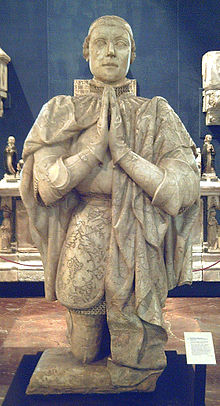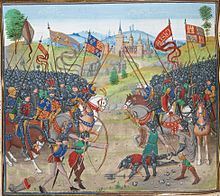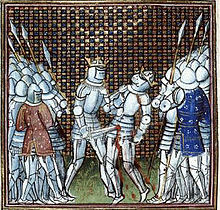Peter of Castile
[2] According to chancellor and chronicler Pedro López de Ayala, he had a pale complexion, blue eyes and very light blonde hair; he was 1.83 metres (6 ft 0 in) tall and muscular.He was to be married to his contemporary Joan, the second and favourite daughter[3] of King Edward III of England; however, on their way to Castile she and her retinue travelled through cities infested with the Black Death, ignoring townspeople who had warned them not to enter their settlements.[6] In the summer of 1353, the young king was practically coerced by his mother and the nobles into marrying Blanche of Bourbon; he deserted her at once upon hearing rumors that she had slept with his half-brother Fadrique, who was supposed to be guarding her virtue and made her instead "an unwilling Isolde to his Tristan," according to one historian.[who?]French historians claim that Peter ordered two Jews to murder her;[9] another version of the story says she was poisoned; a third one that she was shot with a crossbow,[10] although it may have been the plague.He was assailed by his bastard brother Henry of Trastámara at the head of a host of soldiers of fortune,[10] including Bertrand du Guesclin and Hugh Calveley, and abandoned the kingdom without daring to give battle, after retreating several times (first from Burgos, then from Toledo, and lastly from Seville) in the face of the oncoming armies.Peter offered du Guesclin 200,000 gold coins and several towns, including Soria, Almazán, and Atienza to betray Henry."[citation needed] Having dispatched his half-brother, Henry left Peter's body unburied for three days, during which time it was subjected to ridicule and abuse.From The Monk's Tale O noble, O worthy PETRO, glorie OF SPAYNE, Whom Fortune heeld so hye in magestee, Wel oughten men thy pitous death complayne!Even López de Ayala confessed that the king's fall was regretted by many, among them the peasants and burghers subjected to the nobles by late feudal gifts and by the merchants, who enjoyed security under his rule.The English Lake Poet Robert Southey was presented in 1818 with a copy of a five-act play by the novelist Ann Doherty, entitled Peter the Cruel, King of Castile and Leon.But his moral superiority was reduced too by the violent means, including fratricides, by which he sought to suppress opposition; he at times was extremely despotic and unpredictable, even by the standards of his age.The death of King Peter ended the traditional alliance of Castile and Navarre with England, which had been started by the Plantagenets to keep France in check.Strictly speaking, Peter was not defeated by Henry but by the opposing aristocracy; the nobles accomplished their objective of enthroning a weaker dynasty (the House of Trastámara), much more amenable to their interests.[citation needed] Most of the bad stories about Peter are likely to be colored by black legend, coined by his enemies, who finally succeeded in their rebellion.






Peter I of PortugalKing of CastileAlfonso XIHenry IIBurgosCastileMontielToledoSeville CathedralMaría de PadillaBlanche of BourbonJuana de CastroConstance, Duchess of LancasterIsabella, Duchess of YorkCastilian House of IvreaAlfonso XI of CastileMaria of PortugalAlabasterSpanishHouse of IvreaPope Urban VMonasterio de Santa María la Real de Las HuelgasPedro López de AyalaEdward III of EnglandBlack DeathmaravedísAlburquerqueSegoviaMedina SidoniaAragonWar of the Two PetersCastilian Civil WarHenry of TrastámaraBertrand du GuesclinHugh CalveleySevilleGaliciaIberian PeninsulaSantiagoBattle of NájeraHenry II of Castilepogromsforced conversionsSamuel ha-LeviFroissart's ChroniclesEdward, the Black PrincecortesCórdobaPalenciaValladolidAsturiasAndalusiaOrder of SantiagoLópez de AyalaThe Monk's TaleMuseo del PradoPero López de AyalaGeoffrey ChaucerThe Canterbury TalesJohn of Gaunt, 1st Duke of LancasterRobert SoutheyAnn DohertycentralizationAlfonso XPlantagenetsTrastámarasTudorsFernandine Warsportuguese kingFerdinand Ihistorical alliance between Portugal and EnglandJohn of GauntCastilleConstanceDuke of LancasterIsabellaEdmund of Langley, 1st Duke of YorkJoan of PortugalDominican conventProsper MériméeHouse of Trastámarablack legendCharles I of SpainIsabella I of CastileThe Catholic MonarchsDon Pèdre, roi de CastilleVoltaireStephen, LeslieDictionary of National Biographypublic domainHannay, DavidChisholm, HughEncyclopædia BritannicaMonarchsHouse of JiménezSancho IIAlfonso VIUrracaHouse of BurgundyAlfonso VIISancho IIIAlfonso VIIIHenry IBerengariaFerdinand IIISancho IVFerdinand IVJohn IHenry IIIJohn IIHenry IVIsabella IFerdinand VJoannaPhilip IHouse of HabsburgCharles IPhilip IIPhilip IIIPhilip IVCharles IIHouse of BourbonPhilip VAstur-Leonese houseAlfonso IIIGarcía I
